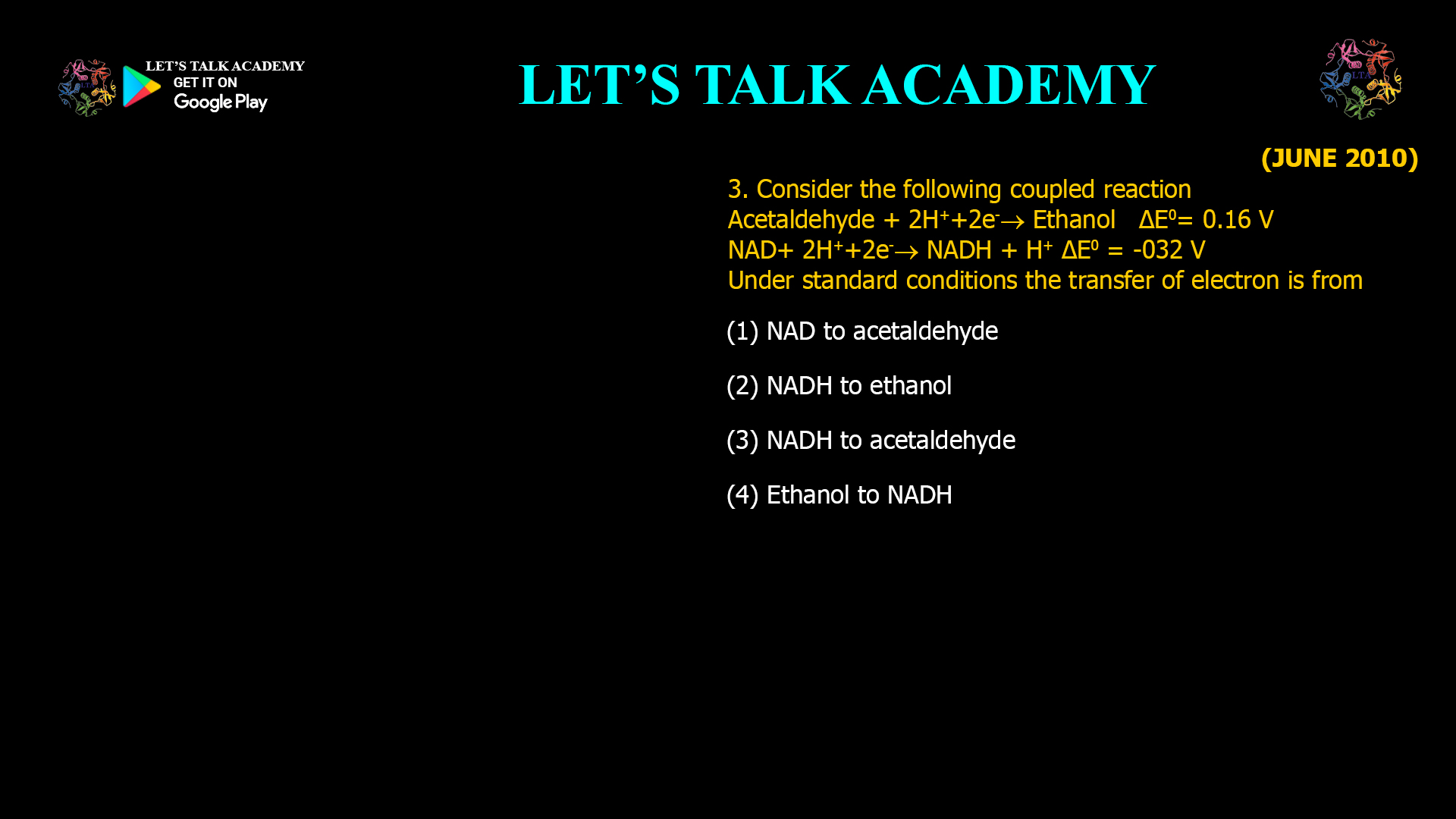- Consider the following coupled reaction
Acetaldehyde + 2H++2e– à Ethanol ΔE0= 0.16 V
NAD+ 2H++2e– à NADH + H+ ΔE0 = -032 V
Under standard conditions the transfer of electron is from
(1) NAD to acetaldehyde
(2) NADH to ethanol
(3) NADH to acetaldehyde
(4) Ethanol to NADH
In biochemical systems, coupled redox reactions are essential for energy transfer and metabolism. One such important reaction involves the reduction of acetaldehyde to ethanol, coupled with the oxidation of NADH to NAD+. Understanding which molecule donates electrons in this process relies on comparing their standard redox potentials (E0).
The Coupled Reaction and Redox Potentials
Consider the following half-reactions with their standard redox potentials:
-
Acetaldehyde + 2H^+ + 2e^- → Ethanol ΔE0 = +0.16 V
-
NAD^+ + 2H^+ + 2e^- → NADH + H^+ ΔE0 = -0.32 V
Note: The NAD^+/NADH couple is often represented with E0 ≈ -0.32 V, indicating its strong reducing power when in the NADH form.
Determining Electron Flow Direction
Electrons flow spontaneously from the half-reaction with lower redox potential to the one with higher redox potential. Here:
-
NADH/NAD^+ couple has a redox potential of -0.32 V (more negative)
-
Acetaldehyde/ethanol couple has a redox potential of +0.16 V (more positive)
This means NADH donates electrons to acetaldehyde, reducing it to ethanol.
Evaluating the Options
-
NAD to acetaldehyde: NAD^+ is the oxidized form and cannot donate electrons; this is incorrect.
-
NADH to ethanol: NADH donates electrons to acetaldehyde, not to ethanol (the product); this is incorrect.
-
NADH to acetaldehyde: Correct. NADH donates electrons to acetaldehyde, reducing it to ethanol.
-
Ethanol to NADH: Ethanol would have to donate electrons to NAD^+, which is not spontaneous under standard conditions; this is incorrect.
Conclusion
The correct electron transfer under standard conditions is from NADH to acetaldehyde, facilitating the reduction of acetaldehyde to ethanol.
Answer: (3) NADH to acetaldehyde
Additional Context
This reaction is catalyzed by alcohol dehydrogenase in biological systems, where NADH serves as the electron donor, and acetaldehyde is the electron acceptor. The favorable redox potential difference drives the reaction forward, allowing cells to regenerate NAD^+ for glycolysis and produce ethanol, especially under anaerobic conditions.




7 Comments
Pallavi Ghangas
September 23, 2025NADH to acetaldehyde
Kirti Agarwal
September 24, 2025NADH to Acetaldehyde
Heena Mahlawat
September 25, 2025Nadh to acetaldehyde
Roopal Sharma
September 25, 2025Nadh to acetaldehyde
Minal Sethi
September 25, 2025NADH to acetaldehyde
Manisha choudhary
September 26, 2025Yeast m anaerobic glycolysis hota h tb pyruvate s lactate nhi bnta ,pyruvate s alcohol bnata h
Pyruvate , pyruvate decarboxylase enzyme k through acetaldehyde m convert ho jata h co2 release ho jaati
Acetaldehyde, alcohol dehydrogenase enzyme k through alcohol m convert hota h ,2 molecule k liye 2NADH consume hote h NADH. Apne electrone and H+ acetaldehyde ko transfer krte h
Kajal
October 5, 2025High negative to positive